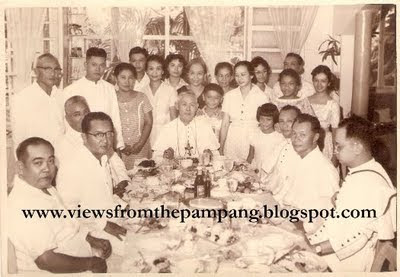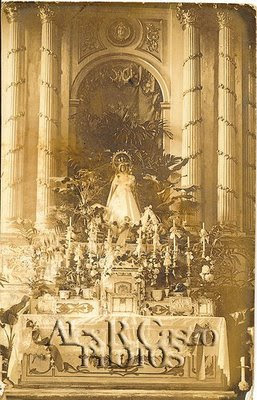 PARTING AND DEPARTING. Jesusa C. Del Rosario, my favorite aunt, with families and friends seeing her off at the Manila International Airport, a few moments before her departure for the U.S. East Coast in 1964.
PARTING AND DEPARTING. Jesusa C. Del Rosario, my favorite aunt, with families and friends seeing her off at the Manila International Airport, a few moments before her departure for the U.S. East Coast in 1964.I was going through the albums of my dear old Imang Susing ( center, in a plaid Jackie O. outfit and pointy white framed glasses) and I found this photo of my auntie about to leave for the U.S. of A. in 1964 to try her luck as an OFW (Overseas Filipino Worker) in
Call it overkill, but that’s how we Del Rosarios are. We move in packs, we travel in groups and we fill parties to the rafters with our presence. One call is all it takes to send Del Rosarios from Manila and Pampanga to come together for a reunion, a niece’s or a nephew’s wedding, a funeral, and in this instance, an airport despedida for an aunt.
Imang Susing’s full and half-siblings came in full force, as I see from this picture. Padre Maning, in his white sutana, stands second from right. I think he is forcing a smile here; my old maid aunt was his longtime housemate at the San Roque Church and I am sure he felt a bit sad letting her go. Youngest sister, Imang Baby and my mother are also here (she’s the one holding the biggest handbag in front, with my 2 year old sister Susan beside her). Two brothers are kneeling in front, Tatang Carling and balding Tatang Pabling. Imang Susing is flanked by a sister-in-law, Imang Perling (Justice Jose Gutierrez David’s daughter, married to Conrado del Rosario, another brother) and family friend Conching Rosal, the operatic soprano star. The coterie also includes a dozen Tinio nephews and nieces, grandchildren and more in-laws.
Unfortunately, Imang Susing’s great American dream was not meant to be; she went home just after a year in the Big Apple. Even then, she learned valuable life lessons from her foreign adventure--living away from family, she took care of herself, but also discovered her own limits and potential. When she came back, she returned to keep Padre Maning company in his Blumentritt assignment.
Imang Susing, (born Jesusa Del Rosario y Castro, 7 Oct. 1926) was your typical terror-aunt, or so I thought when I was much younger. Being a single adult, we tended to typecast her in the usual old maid mold—strict and surly. Her sharp, well-manicured fingernails were ready to pinch us when we bawled and made crying scenes at family affairs. She was always curt in her responses, unflinching with her comments. When we cousins from the province came to
Imang Susing would cut a snazzy figure when she went to work at the Department of Finance. She would jump into her noisy Volkswagen, a lighted cigarette between her fingers, and she was off. On some days, she would cram 3 or 4 nephews in the car and drive us around Avenida. She would remind us, “Anyapin eku mikyasawa, eku buri ing mika responsibilidad. Pero lawen yun ngeni—ikayu ing kakung meging responsibilidad!”. ( I didn’t want any responsibility, so that’s why I didn’t get married. But now look—you’ve all become my responsibilities!).
Indeed, Imang Susing cared for us in silent, self-effacing ways. Come tuition time, she would surprise my mother—her younger sis—with a big alkansiya (piggy bank) full of coins collected over time—“pang-daily allowance for your anak!”. When we would get into the nerves of my uncle Padre Maning and would get a lashing, it was Imang Susing who shielded us from his temper. Still, when yet another cousin appeared at the rectory already cramped with our presence, it was Imang Susing who offered to share her small bedroom with him.
When Imang Susing retired, she went back to Pampanga to live at the Del Rosario Compound in Abacan. By then, her beloved brother, Padre Maning had passed away in 1987. She kept an “open house”—with Del Rosario relatives coming and going to visit or to chit-chat. I would often drop by every week-end to check on her and have afternoon coffee.
Everything went fine until she got sick of cancer sometime in early 1991. I was already working abroad at this time so I could only get intermittent updates about her health. But my feisty Imang Susing beat the “Big C” and went on remission for over 10 years. Her cancer came back with a vengeance in 2003 and once more, the Del Rosarios came together to help her in this new, and final crisis.
Thank God, I was already home by then, and I would often try boosting her morale by accompanying her regularly to her doctor's appointments. When she was confined and worried about her finances, it was the turn of nephews and nieces--now scattered around the world--to pass the hat for her hospital funds. Another nephew mobilized acquaintances to donate blood for her transfusion.
When the inevitable did come for Imang Susing one sad March morning, Del Rosarios gathered once more in droves to give her a final send-off. Her surviving siblings, in-laws nephews, nieces, grandchildren, friends and high school classmates turned up to celebrate her life full of unselfishness and generosity. At her cremation, she was surrounded by our presence, not unlike her despedida picture over 40 years ago. I am sure my dear Imang Susing had a great flight and arrived at her Final Destination on wings of love and prayer.
(*NOTE: Feature titles with asterisks represent other writings of the author that appeared in other publications and are not included in the original book, "Views from the Pampang & Other Scenes")














